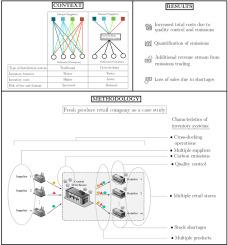Cross-docking in retail: Sustainable EOQ-based models for multi-item inventory systems with imperfect quality and stockouts under carbon cap-and-trade
IF 6.8
Q1 OPERATIONS RESEARCH & MANAGEMENT SCIENCE
引用次数: 0
Abstract
Cross-docking is a widely used strategy for inventory consolidation and distribution in complex retail supply chains involving multiple suppliers, products, and retailers. This strategy reduces the costs of managing inventory in retail operations by streamlining the supply chain from the point of origin to the point of sale. Environmental sustainability is a crucial concern in operations management, necessitating the monitoring of emissions generated by supply chain activities. Additionally, quality control is vital in retail supply chains to ensure consumer health is not compromised by the sale and consumption of poor-quality products. Taking these factors into account, this paper proposes a sustainable inventory model for a cross-docking system that includes multiple suppliers, retailers, and items with imperfect quality, all under cap-and-trade emissions regulation. Data from a retail company with a single warehouse and multiple stores is used to formulate the inventory system as a mixed-integer non-linear programming problem. The warehouse serves as a hub for cross-docking operations, consolidating inventory from multiple suppliers and distributing it to various stores. The results indicate that the fraction of imperfect quality items, carbon emissions cap, and price for emissions in the open carbon market significantly impact total inventory costs and emissions. Incorporating these variables results in a 9% increase in total costs compared to scenarios where they are excluded. However, this approach enables precise quantification of emissions. To explore the impact of stock shortages on retail operations, the model is extended to include backordering. The extension demonstrates that stock shortages adversely affect total costs.

零售业的交叉对接:碳限额与交易下质量不完美和缺货的多项目库存系统的可持续eoq模型
在涉及多个供应商、产品和零售商的复杂零售供应链中,交叉对接是一种广泛使用的库存整合和分销策略。该策略通过简化从原产地到销售点的供应链,降低了零售业务中管理库存的成本。环境可持续性是业务管理的一个关键问题,因此必须监测供应链活动产生的排放。此外,质量控制在零售供应链中至关重要,以确保消费者的健康不会因销售和消费劣质产品而受到损害。考虑到这些因素,本文提出了一个可持续的交叉对接系统库存模型,该系统包括多个供应商、零售商和质量不完美的商品,所有这些都在限额与交易排放监管下。从一个零售公司的单一仓库和多个商店的数据来制定库存系统作为一个混合整数非线性规划问题。该仓库作为交叉对接操作的中心,整合来自多个供应商的库存并将其分发到各个商店。结果表明,不完善项目的比例、碳排放限额和排放价格对总库存成本和排放有显著影响。与不考虑这些变量的情况相比,纳入这些变量的总成本增加了9%。然而,这种方法能够精确地量化排放。为了探讨库存短缺对零售业务的影响,将模型扩展到包括缺货。扩展表明,库存短缺对总成本产生不利影响。
本文章由计算机程序翻译,如有差异,请以英文原文为准。
求助全文
约1分钟内获得全文
求助全文

 求助内容:
求助内容: 应助结果提醒方式:
应助结果提醒方式:


